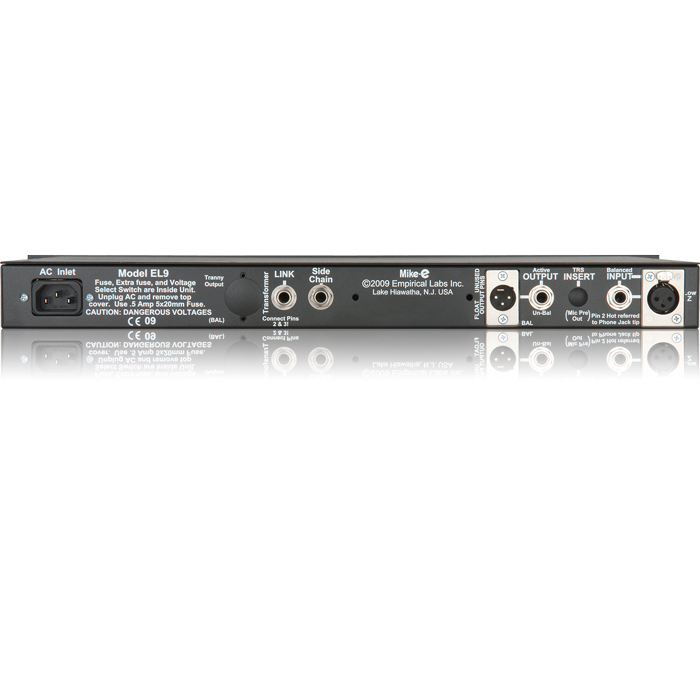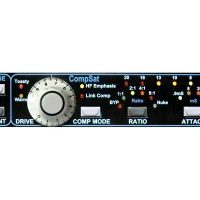Product omschrijving
Modern Digitally Controlled Microphone Preamp
In today’s modern age of digital recorders, DAWs and software plug-ins, Mike-E is the ultimate solution for getting a clean and strong, yet warm and musical signal into the box…and it couldn’t be easier to work – its front panel layout is so straight ahead that even inexperienced engineers will have no problem moving around on it right away.
When the engineering team at Empirical Labs sets out to build a microphone preamp, you can be sure it’ll deliver spectacular sound, be effortless to work, and will provide features unlike any other device in its class. To that end, we proudly present Mike-E, a high performance transformer-coupled mic preamp with a noise floor far below any microphone’s self noise, combined with a one-of-a-kind compressor/saturator circuit that delivers classic knee compression as well as versatile tonal ‘coloring’ that can replicate many of the best characteristics of vintage analog recording equipment.
Mic Preamp
The Mike-E features a super low noise transformer input amplifier section with the gain under precise digital control. The signal to noise far exceeds any microphone in existence. Having used many mic preamps over the years, we’ve implemented a unique stepped gain control that should be impervious to the normal flakiness that age causes to pots and detented switches. A “Bad!” LED indicates when the input signal is overloading the circuit.
CompSat™
The CompSat’s unique circuitry sets the Mike-E apart from all other mic preamps.
SATURATOR – a multi stage soft-clipping circuit. At lower levels, a triode-type saturation affects the signal. As the level increases, a second unique clip circuit starts to more severely flatten out the peaks.
COMPRESSOR – based on ELI’s world famous Distressor, but with other characteristics (including a much longer attack time). Preset ratios include: 2:1, 4:1, 8:1…and, of course, Nuke.
EMPHASIS – a two-stage circuit that boosts and soft clips high frequencies before the CompSat™ circuit, and then cuts the frequencies after it. Emphasis has the added perk of improving signal to noise, and is the reason analog tape decks used emphasis to begin with.
Specifications
- Frequency Response – 3 Hz to 200 kHz on (No CompSat). CompSat is 3Hz – 150Khz. Optional Transformer output is 6Hz–80kHz.
- Signal to Noise – 130 dB signal to Noise.at 40dB gain. Maximum output is +28dBu.
- Distortion – Ranges between .0006% and 15% depending on mode and settings.
- I/O – Transformer coupled Input, Active and Transformer Outputs available. High quality audio caps used internally.
- Impedance – Input Impedance is above 600 Ohms at all frequencies, transformer coupled. Output impedance is less than 38 ohms. Instrument In Impedance is 332K Ohms.
- Attack/Decay Ranges – .9 – 70mS attack. .15 – 1 Sec.
- Power Consumption – 15 Watts Max.
- Metal Chassis – single height 1.75″ high, 10″ deep, 19″ wide.
- Shipping info – Box dimensions 22.5″ x 18.5″ x 3 1/4″.
Can I use 2 Mike-E’s as a buss compressor?
Yes, you can! You will probably put the Mic Gain on Line (0dB Gain). Generally you would use a low ratio (2:1), with the slowest attack (100mS) on such a mixdown compressor. However, the MIX control offers a whole other approach to Stereo Buss compression. More on that later. For now lets assume the MIX control is full CW (10) and you are hearing only the compressor output. For the loudest MIX, keep the release fast also (.05S). With the Slow attack and fast release, the transients will come through without over compression, and the fast release will keep the music from pumping after an attack. 1 – 3 dB is usually enough gain reduction.
Can the CompSat section emulate analog tape?
Put the CompSat on 1:1, and adjust drive so the warm light is on often, and the Toasty LED lights on peaks. Set the Mix Control to full CW (10) and the user will gain a dB or two of “heat” and headroom. The Mike-E will be flattening the peaks out gently with its saturation circuit. Engaging the Emphasis will make the high frequencies clip earlier and soften peaky and possibly harsh “build-ups”. It has the added benefit of decreasing noise. Emphasis was used in all modern tape recorders to improve Signal to Noise and dynamic range. Going to another compressor after this will give you a familiar tape like vocal sound. Compressors react differently after a signal has been soft clipped, or on tape.

 Product is toegevoegd aan uw winkelwagen
Product is toegevoegd aan uw winkelwagen



